An In-Depth Exploration of Green Rocks and Crystals
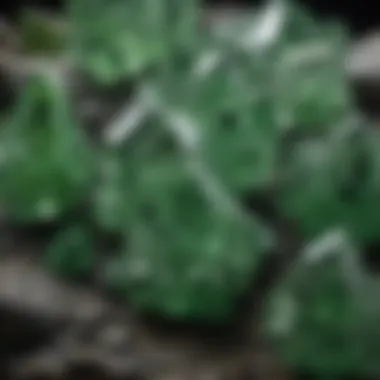
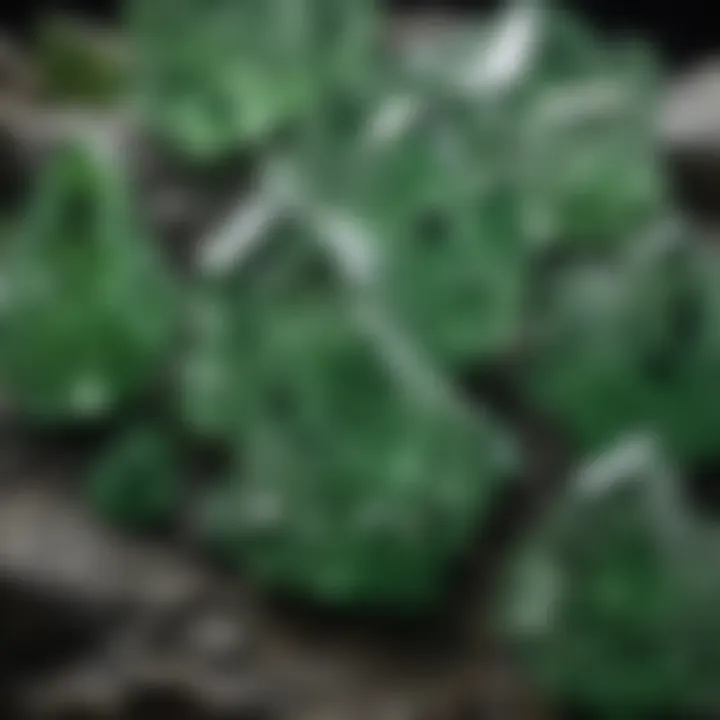
Intro
The realm of green rocks and crystals offers a rich tapestry woven from geological wonders and cultural narratives. This article seeks to illuminate the various aspects of these captivating minerals, emphasizing their formation processes, diversity, and significance across various contexts. As we journey deeper into this exploration, we will uncover not only the distinguishing features of these green gems but also their applications in different industries and their roles in folklore and healing practices.
Featured Collectible of the Month
Overview
For this month, we spotlight serpentine, a fascinating green mineral that captivates collectors and enthusiasts alike. Known for its unique shades ranging from light green to dark green, serpentine often exhibits a smooth, waxy luster. Its presence can be found in various geological settings, making it a sought-after specimen. Serpentine is not only visually striking but also boasts interesting characteristics that reflect its formation.
Historical Significance
Serpentine has held cultural importance for centuries. Historically, indigenous peoples utilized serpentine for tools and ornamentation, associating it with protection and healing. The ancient Greeks believed it to be a stone of rejuvenation. Today, its significance has evolved, with many crystal enthusiasts embracing its alleged properties of promoting tranquility and personal growth.
"Serpentine is more than just a mineral; it is a symbol of nature's resilience and adaptability."
Identification Techniques
Visual Characteristics
When attempting to identify green rocks and crystals, visual characteristics play a crucial role. Key aspects to consider include:
- Color Variety: Depending on the presence of iron or magnesium, green minerals can display a range of hues.
- Luster: Examine the surface. Is it glassy, silky, or dull? This can indicate its classification.
- Hardness: Using the Mohs scale, assess the hardness by attempting to scratch the mineral with a known standard.
- Transparency: Is the rock opaque, translucent, or transparent? This helps narrow down possibilities.
Understanding these characteristics assists collectors in identifying specific specimens.
Resources for Identification
In the modern age, resources for identifying green rocks and crystals are widely available. Key platforms include:
- Wikipedia for foundational knowledge on mineralogy.
- Britannica for historical and scientific insights.
- Reddit communities that provide real-time discussions among collectors.
- Facebook groups where enthusiasts share experiences and identification tips.
As we proceed through the article, these foundational insights will pave the way for a deeper understanding of green rocks and crystals, how they are formed, their cultural relevance, and practical tips for collectors.
Preamble to Green Rocks and Crystals
Green rocks and crystals are not just visually striking; they carry layers of significance in geology and culture. The exploration of these minerals can enhance our understanding of Earth’s processes and the ways in which humans interact with natural resources. In this article, we emphasize the critical role green minerals play in our world, inviting both enthusiasts and collectors to appreciate their unique characteristics.
Definition of Rocks and Crystals
Rocks are solid aggregates composed of one or more minerals or mineraloids. Crystals, on the other hand, refer to solid materials whose atoms are arranged in a highly ordered structure, forming specific geometric shapes. Green rocks and crystals emerge through various geological processes, including volcanic activity, sedimentation, and metamorphism. Notable examples include jade and malachite, each presenting distinct physical and chemical attributes.
Importance of Color in Mineral Identification
Color is an essential factor in identifying minerals, including green specimens. The green hue can derive from various elements, such as iron, chromium, or copper, each contributing to the stone's unique aesthetic and properties. While color aids in initial identification, additional factors like luster, hardness, and specific gravity offer critical insights into classification. Understanding the nuances of color not only assists in distinguishing minerals but also influences their value and desirability in the market.
"Relying solely on color can be misleading in mineral identification; comprehensive analysis is always recommended."
Grasping the significance of green rocks and crystals provides a foundation for deeper exploration into their geological formation and cultural relevance.
Geological Formation of Green Minerals
Understanding the geological formation of green minerals is crucial for comprehending their properties and significance. This topic investigates how the mineral composition and environmental factors influence the formation processes. Green rocks and crystals acquire their vibrant color from specific chemical elements such as iron, chromium, and nickel. Their formation is closely tied to geological activity, which not only creates the minerals themselves but also determines their distribution around the globe.
The Role of Geological Processes
Geological processes are fundamental in the creation of green minerals. These processes include metamorphism, igneous intrusion, and sedimentation. For instance, during metamorphism, existing rocks are subjected to extreme heat and pressure, leading to changes in their mineral composition. Green schist, a metamorphic rock, is a prime example where minerals like chlorite give it a distinctive green hue.
Igneous processes involve the cooling of molten magma, which can produce minerals like olivine, known for its olive-green color. Furthermore, sedimentary processes allow minerals to form through the accumulation and lithification of sediments, often incorporating green minerals when conditions permit.


"The color and characteristics of green minerals are not only visually striking but also tell a story about the Earth's history and the conditions under which they formed."
Common Environments for Green Crystals
Green crystals typically form in various geological environments, which contribute to their unique attributes.
- Volcanic Regions: These areas often yield green minerals such as peridot, formed in the depths of the Earth under high temperature.
- Metamorphic Terrains: In these regions, minerals like diopside and actinolite develop under intense heat and pressure, resulting in their characteristic green colors.
- Sedimentary Basins: Some green minerals like green clay minerals emerge from the weathering of existing rocks, promoting the formation of clays that can display green shades.
Identifying the environments where green minerals are found can help enthusiasts understand the geological history associated with those minerals. Collectors benefit from this knowledge, as it adds context to their specimens, enriching their collection experience.
In summary, the geological formation of green minerals is a complex interplay of various processes and environments. Knowing the underlying factors not only enhances the appreciation of these specimens but also offers vital insights into our planet's dynamic history.
Types of Green Rocks
Understanding the different types of green rocks is vital for both collectors and enthusiasts. Green stones represent a diverse range of materials, each with unique characteristics and uses. Their values can vary greatly depending on their rarity, quality, and many other factors. In various cultures, these green minerals often symbolize healing, renewal, and prosperity, contributing to their desirability in the market.
Examples of Common Green Stones
Jade
Jade is one of the most revered and sought-after green stones worldwide. Known for its durability and aesthetic appeal, it comes in two main varieties: jadeite and nephrite. The key characteristic of jade is its often intense green color, which can vary from light to deep shades. This stone is highly regarded for its cultural significance, particularly in East Asian societies, where it is associated with good luck and harmony.
One unique feature of jade is its tough, resilient nature. This makes it an excellent choice for carving intricate designs and jewelry. However, its popularity also leads to difficulties in sourcing genuine jade from imitations. Buyers should exercise caution and seek certified stones to avoid disappointment.
Malachite
Malachite is another prominent green stone, easily recognized by its banded patterns and vibrant green hues. This mineral is often used in jewelry and decorative items due to its striking appearance. Its primary characteristic is that it exhibits rich, swirling patterns that are not only visually appealing but also unique to each piece.
Malachite's unique feature is its ability to absorb negative energy, as believed in various cultures. However, it is important to note that this stone can be sensitive to acids and heat, which may restrict its application in some environments. Therefore, careful handling is essential when using malachite in jewelry or art.
Green Quartz
Green Quartz, a variety of quartz, is well-known for its clarity and translucence. This stone is attractive to collectors for its affordability and versatility. The key characteristic of Green Quartz is its availability in different shades of green, from subtle pastels to more saturated tones.
A unique feature of Green Quartz is its often stable and reliable nature, making it suitable for various applications, including jewelry and decorative pieces. While it does not possess the same cultural prestige as jade or malachite, Green Quartz serves as an accessible option for those looking to include green rocks in their collection.
Rare Green Rocks and Their Properties
Green Serpentine
Green Serpentine is less commonly known but exhibits interesting properties. Its distinctive green color ranges from light to dark shades, often displaying a mottled or banded appearance. The primary characteristic of Green Serpentine is its high magnesium content, which contributes to its unique texture. This stone is a popular choice for those interested in its purported metaphysical properties, as it is believed to assist in healing and emotional balance. However, collectors should be aware that Green Serpentine can be softer than other stones, making it more prone to scratches and damage.
Green Turquoise
Green Turquoise is a stunning mineral, often prized for its vibrant green to blue-green color. Like jade, turquoise has a significant place in many cultures, often being associated with protection and healing. The key characteristic of Green Turquoise is its distinctive matrix patterns, which can vary significantly from one specimen to another. A unique feature of this stone is its use in both jewelry and art pieces. However, authentic turquoise can be hard to find, and many imitations exist. Collectors should seek pieces with provenance or certifications to ensure quality and authenticity.
Fascinating Green Crystals
Green crystals hold a special allure within the broader spectrum of mineralogy. Their vibrant colors and unique properties not only captivate collectors but also draw attention from those interested in mystical and holistic practices. This section aims to explore notable green crystals and their distinct characteristics, offering insights into their aesthetic and functional values.
Overview of Notable Green Crystals
Several green crystals stand out due to their popularity and remarkable features. Here are some worth noting:
- Emerald: Recognized as one of the most valuable green gemstones, emerald is a member of the beryl family. Its intense green hue often signifies high quality and rarity.
- Green Tourmaline: Known for its diverse shades of green, from light to dark tones, this crystal is admired in both jewelry and healing practices.
- Peridot: On occasion called the evening emerald, peridot is valued for its light green color. It is often associated with warmth and positivity.
- Serpentine: This mineral often exhibits a rich green color with mesmerizing patterns. It is significant in various cultures for its protective qualities.
These crystals are not only alluring visually but also play roles in different applications, from jewelry making to therapeutic practices.
Physical and Chemical Properties
Understanding the physical and chemical properties of green crystals helps delineate their uniqueness. Here are key features to consider:
- Crystal Structure: Many green crystals have specific crystal structures that play a role in their overall appearance and durability. For example, emerald has a hexagonal crystal system, which contributes to its characteristic facets.
- Hardness: The Mohs scale of mineral hardness provides insight into a crystal's durability. Emerald, for instance, ranks around 7.5 to 8, making it suitable for various forms of adornment.
- Color Variation: Factors like mineral inclusions and the presence of trace elements influence the shade of green. The presence of chromium and vanadium enhances the vibrancy in emeralds.
- Luster: Luster varies among green crystals, from glassy to waxy. Serpentine tends to display a more waxy sheen, adding to its visual depth.
"The complexity of each green crystal, from its formation to its unique properties, provides endless fascination for collectors and enthusiasts alike."
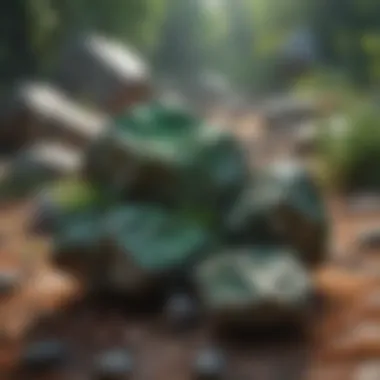

Identification and Classification
Identification and classification of green rocks and crystals play a vital role in the study and appreciation of these unique natural forms. Not only do they offer insights into the composition and origin of minerals, but they also enable collectors to distinguish valuable specimens from less significant ones. A well-informed collector can appreciate the nuances of various minerals, elevating both their expertise and the quality of their collection.
Understanding the intricacies of identification is essential for several reasons. Firstly, many green rocks and crystals can appear similar to the untrained eye. Subtle differences in hue, texture, or structure can determine their classification. Secondly, knowing how to classify these minerals can affect their market value. Certain varieties, such as jade or malachite, represent significant investments, while others may not hold as much monetary worth.
Additionally, identification allows collectors to uncover historical and geological narratives. Each mineral tells a story of the conditions under which it formed. Thus, a deeper knowledge can lead to a broader appreciation of the Earth's processes. Furthermore, collectors can better contribute to discussions surrounding conservation efforts, given that some green crystals are becoming increasingly rare due to environmental factors.
In summary, Solid expertise in identification and classification not only enhances appreciation but also empowers collectors in making well-informed decisions regarding their collections.
Key Indicators of Green Rocks and Crystals
When identifying green rocks and crystals, certain key indicators can significantly aid in the classification process. These indicators include:
- Color Variations: The shade of green can range from pale mint to deep emerald. Each hue often signifies different mineral compositions or impurities.
- Texture: The surface texture may vary from smooth and glossy to rough and fibrous. This can reflect a mineral's crystallization process or external environmental factors.
- Hardness: Utilizing the Mohs scale of hardness can provide insight into the mineral's composition. This helps in comparing and contrasting different specimens effectively.
- Streak: The streak test, which involves scraping the mineral on a hard surface to reveal its powder color, is another critical indicator. This powder can sometimes provide more consistent and reliable information than the rock's surface color.
- Transparency: The extent to which light can pass through a specimen influences its classification.
By observing these indicators carefully, collectors are better positioned to identify specific minerals and their properties accurately.
Using Luster and Clarity for Identification
Luster and clarity are essential components of mineral identification. Luster refers to the way light interacts with the surface of a mineral. It can be classified into various types:
- Glossy: Often found in minerals like malachite, where a shiny finish is present.
- Dull: Crystals like green serpentine will present a more matte appearance.
- Adamantine: An almost diamond-like luster can be observed in high-quality green tourmaline.
Clarity, on the other hand, describes the transparency and internal features of a mineral. Clearer specimens tend to be more valuable and desirable in the market. Those with inclusions may tell more about their formation processes but could have less commercial value.
In practice, examining both luster and clarity can help in distinguishing between closely related mineral species. For example, the luster and clarity of green quartz may differ from that of green fluorite, aiding collectors in making precise identifications. By focusing on these factors, collectors can deepen their understanding of their specimens and enhance their collection significantly.
Uses and Applications
The study of green rocks and crystals goes beyond aesthetics. It reveals how these vibrant stones are integrated into various sectors and how they hold cultural significance across different societies. Understanding their applications can offer insights into their value and importance. This section focuses on the industrial uses of green stones and the cultural context surrounding green crystals.
Industrial Uses of Green Stones
Green stones have a variety of practical applications that are utilized across industries due to their unique properties. Here are some notable usages:
- Construction Materials: Green stones like jade and serpentine are often quarried for decorative elements in buildings, such as tiles and countertops. They provide both strength and an appealing look.
- Jewelry and Ornamental Items: Many green crystals, including malachite and green quartz, are fashioned into jewelry pieces. They are prized for their beauty, making them sought after in both fashion and artisan markets.
- Electronic Components: Some green minerals, notably green fluorite, have roles in the manufacturing of certain electronic components. Their unique properties make them suitable for specific high-tech applications.
- Therapeutic Products: In the wellness sector, stones like green aventurine are ground into powders to be used in skincare and holistic therapies. Their reputation extends to those seeking natural remedies.
- Crafts and Art: Green stones are often utilized in crafting and artistic endeavors. Artists may use malachite or green calcite to create sculptures or artwork that capitalizes on their unique color and texture.
Cultural Significance of Green Crystals
Culturally, green crystals hold varied meanings and significance across societies. Here are some key aspects:
- Symbolism of Growth and Harmony: Green is often associated with growth, nature, and renewal. In many cultures, green crystals symbolize balance and healing. For example, jade is believed to attract good luck and preserve harmony in relationships.
- Crystals in Healing Practices: In alternative medicine, green crystals are central to the practice of crystal healing. Practitioners believe these stones can aid in physical and emotional healing, particularly in terms of issues associated with the heart and lungs.
- Rituals and Spiritual Use: Many societies incorporate green crystals into spiritual rituals. For instance, green tourmaline is thought to foster protection and promote positive energies during meditation.
- Historical Context: Throughout history, various civilizations valued green stones. The ancient Egyptians used malachite for decoration and amulets. In Asian cultures, jade has been revered for millennia as a symbol of status and protection.
Understanding the industrial and cultural applications of green rocks and crystals expands one's knowledge and appreciation for these minerals, further cementing their importance in both practical and symbolic realms.
Market Value and Collecting
Understanding the market value of green rocks and crystals is crucial for both collectors and enthusiasts. This section delves into the key elements that impact the market dynamics for these minerals and provides guidance on how to build a collection effectively. The value of green minerals can vary greatly based on several factors, including rarity, demand, and aesthetic qualities. Knowing how to assess these factors allows collectors to make informed decisions.
Factors Influencing Market Value
Several elements play a significant role in determining the market value of green rocks and crystals. Some of the most prominent factors include:
- Rarity: The scarcity of a mineral directly affects its price. Stones like jade are abundant, while others like green turquoise may be limited in availability.
- Quality: The physical properties—such as clarity, color saturation, and luster—are critical. A deeper green hue usually commands a higher price compared to lighter shades.
- Market Demand: Trends in collecting can shift due to cultural influences or commercial interests. For instance, during periods of increased interest in crystal healing practices, the demand for specific green crystals may rise.
- Provenance: The origin of a stone can add significant value. Minerals sourced from renowned locations or specific geological formations are often viewed as more desirable.
"The market for green rocks and crystals is as dynamic as the minerals themselves. Understanding the underlying factors helps collectors navigate this landscape effectively."
Establishing a Collection of Green Rocks
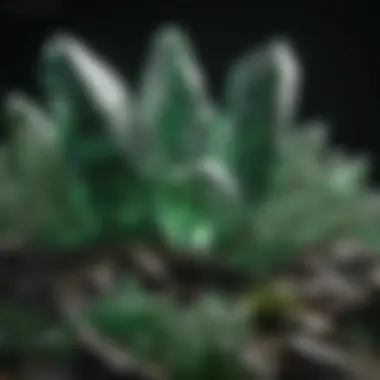
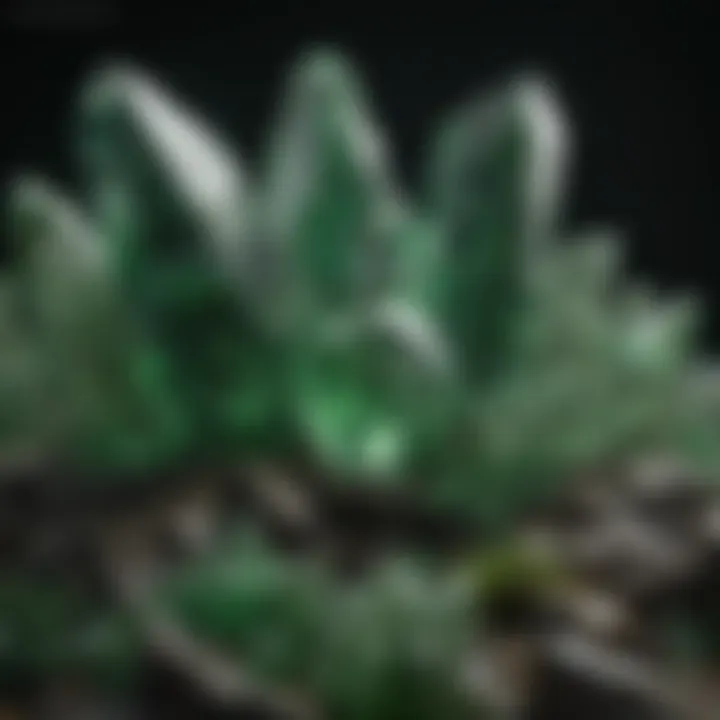
Starting a collection of green rocks requires thoughtful consideration and methodical planning. Here are some key steps and tips to consider:
- Determine Purpose: Consider whether the collection is for investment, personal enjoyment, or educational purposes. This will guide decisions on which minerals to acquire.
- Research and Education: Learn about different types of green rocks, their sources, and their characteristics. Resources like Wikipedia and Britannica can be beneficial for in-depth knowledge.
- Budgeting: Set a budget for purchasing stones. Research current market prices to ensure the budget aligns with potential acquisitions.
- Attend Shows and Join Clubs: Participating in rock shows and joining collector clubs can provide opportunities to buy and trade minerals while building relationships with other enthusiasts.
- Proper Documentation: Maintain records of each mineral's purchase details, including price, seller information, and any certifications of authenticity. This documentation will be valuable for future sales or appraisals.
By following these guidelines, collectors can build a meaningful collection of green rocks and crystals that reflects their passion and knowledge.
Care and Preservation Techniques
Caring for green rocks and crystals is essential for enthusiasts and collectors. Proper maintenance ensures these beautiful minerals retain their charm and value over time. Neglecting care can lead to deterioration, diminished appearance, or even loss of value. Therefore, understanding how to clean, store, and display these specimens is vital.
Cleaning Green Rocks and Crystals
Cleaning green rocks and crystals is not merely about aesthetics. Dust and debris can accumulate, potentially harming the surface of the mineral. Different types of stones and crystals require different cleaning methods. It is crucial to identify the type of mineral first.
- Gentle Soaking: For many crystals, gentle soaking in lukewarm water is sufficient. Avoid using hot water as it may cause thermal shock. Adding a bit of mild soap can help, but minimize the use of any abrasive materials.
- Soft Brush: A soft-bristled brush can effectively remove stubborn dirt or residue. Make sure not to scrub too hard; the goal is to maintain the integrity of the crystal.
- Avoid Harsh Chemicals: Chemicals can damage the surface of your minerals. Always conduct research regarding specific cleaning needs for each type of rock or crystal. For example, certain minerals, like malachite, should never be cleaned with vinegar or acidic solutions.
Storage and Display Tips
Storage and display of green rocks and crystals should balance protection and accessibility. Proper techniques can help prevent damage while allowing collectors to showcase their collections effectively.
- Use Protective Cases: Display cases made from glass or acrylic provide visibility while protecting specimens from dust and accidental damage. Ensure cases are well-ventilated to prevent moisture build-up.
- Individual Storage: Storing each crystal or rock separately can help avoid scratches or chips. Consider using soft fabric bags or padded boxes.
- Avoid Direct Sunlight: UV light can fade some minerals over time. Keep your collection out of direct sunlight, especially for fragile crystals.
- Temperature Considerations: Maintain a stable environment. Extreme fluctuations in temperature and humidity can negatively affect the conditions of rocks and crystals. Store them in a climate-controlled room if possible.
- Labeling: For collectors with extensive collections, clear labeling can help track minerals. Use acid-free materials to avoid chemical reactions with the labels.
Crystal Healing and Folk Beliefs
Understanding crystal healing and folk beliefs is essential for anyone interested in the broader context of green rocks and crystals. These beliefs reflect various cultural narratives that surround the use of minerals, linking them to physical, emotional, and spiritual wellbeing. The significance of these practices cannot be understated, as they provide insight into how societies have interpreted their connection to nature through different eras.
The Beliefs Surrounding Green Crystals
Green crystals hold an esteemed place in many spiritual traditions. They are often seen as symbols of healing and renewal. For instance, it is commonly held that Emerald can enhance emotional balance. Similarly, Malachite is thought to absorb negative energy, acting as a protector. These ideas have prevailed over centuries and continue to attract interest in contemporary wellness culture.
The beliefs are not restricted to anecdotal experiences; various healing practices utilize these crystals. Many enthusiasts claim that holding a green crystal during meditation can enhance clarity and focus. Additionally, some cultures believe that placing a green stone on a specific chakra can promote balance. Such practices open dialogues about the role these crystals play in personal rituals, thereby retaining their relevance.
Practical Applications in Wellness
The application of green crystals in wellness practices is gaining traction. People incorporate them in various forms, including:
- Meditation Tools: Many practitioners use crystals to create an ambiance conducive for meditation. Imagine sitting with Green Aventurine or Peridot, believed to promote emotional well-being.
- Jewelry: Wearing green crystal jewelry is common. Bracelets or necklaces made from Jade or Green Tourmaline are popular for purported protective qualities.
- Elixirs: Some individuals create crystal-infused water with designated green stones. This is based on the idea that the vibrations of the stones can alter the water's energy, although caution is advised about the safety of certain minerals in water.
"Crystals can be seen as tools to facilitate healing rather than guarantees. They can help shift perspectives and create space for growth."
These practices illustrate a personalized approach to wellness, allowing individuals to find their path towards healing. However, it is important to approach such methods with an open but critical mind, recognizing they may complement rather than replace conventional healthcare.
End and Future Trends
The exploration of green rocks and crystals presents a multidimensional viewpoint, merging geological phenomena with cultural significance. In this article, the emphasis was placed on understanding their properties, identification methods, and applications. As the demand for these unique minerals grows, the rising interest among collectors and enthusiasts fosters a deeper relationship between humans and Earth’s natural resources.
Summary of Insights on Green Minerals
Green minerals exhibit a fascinating spectrum of characteristics that reflect their unique origins and environments. Each type of green rock or crystal has distinct physical properties, such as hardness, luster, and color variations, which can serve as indicators for identification.
Some notable examples of green minerals include:
- Jade: Valued for its beauty and historical significance, jade is often associated with cultural rituals and ornamentation.
- Malachite: Known for its striking banded patterns, malachite is often used in jewelry as well as for decorative pieces.
- Green Quartz: This versatile stone is appreciated for its availability and wide application in various industries.
The keen interest in these minerals arises not just from their aesthetic appeal, but also from their implications in industries like construction, jewelry, and alternative wellness practices.
Emerging Trends in Collecting and Usage
The trends in collecting green rocks and crystals are evolving. Enthusiasts are increasingly focusing on sustainable practices, selecting ethically sourced materials. This shift marks a growing awareness of the environmental and ethical implications of rock collecting.
In addition, advancements in technology facilitate access to information, allowing collectors to connect and share insights on platforms like Reddit and specialized Facebook groups. As the online community for collectors expands, members gain the ability to exchange knowledge, trade rare specimens, and discuss market values.
Some noteworthy trends include:
- Increased Digital Engagement: Collectors are turning to virtual platforms to showcase their collections and learn from experts.
- Sustainable Sourcing: A demand for ethically mined and responsibly sourced crystals is reshaping the market.
- Integration of Healing Practices: Many collectors are blending their interests with holistic practices, promoting wellness benefits associated with green crystals.
As the world continues to value sustainability and ethical practices, collectors of green minerals must adapt to these changes, ensuring their passion aligns with broader social and environmental considerations. As new discoveries arise, the relationship between collectors and their gathered treasures will likely deepen, ensuring a vibrant future for this unique segment of the geological world.



